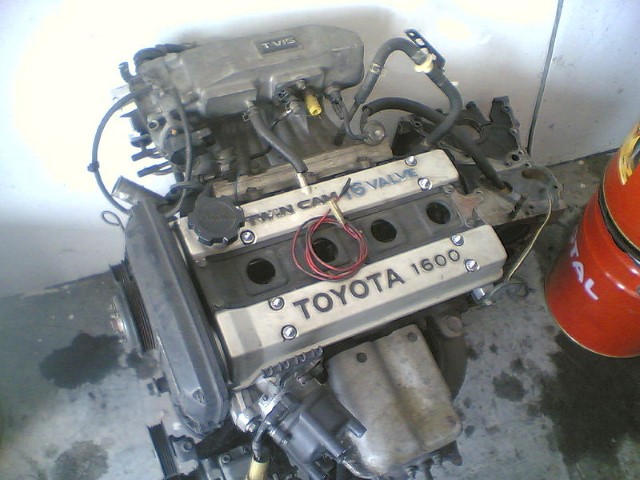4A-GE Toyota engine workshop manual download digital and repair manual
 |
Toyota 4A-GE engine factory workshop and repair manual downloadon PDF can be viewed using PDF reader like adobe , or foxit or nitro File size 68 Mb searchable Fitted to AA63 Carina ,AT160 Carina, AT171 Carina, AA63 Celica, AT160 Celica, AE82 Corolla saloon, FX ,AE86 Corolla Levin, AE92 Corolla , AT141 Corona ,AT160 Corona ,AW11 MR2 ,AE82 Sprinter , AE86 Sprinter Trueno ,AE92 Sprinter , AE82/AE92 Corolla GLi Twincam/Conquest RSi South Africa), Chevrolet Nova , Geo Prizm GSi . Download digital on PDF 1987 Edition manual Service Specification Toyota 4A-GE engine factory workshop and repair online download
|
The cylinder head was developed by Yamaha Motor Corporation and was built at Toyota's Shimoyama plant alongside the 4A and 2A engines. The reliability and performance of these engines has earned them a fair number of enthusiasts and a fan base as they are a popular choice for an engine swap into other Toyota cars such as the KE70 and KP61. New performance parts are still available for sale even today because of its strong fan base. Production of the various models of this version lasted for five generations, from May 1983 through 1991 for 16-valve versions and the 20-valve 4A-GE lasting through 1998.
The first-generation 4A-GE which was introduced in 1983 replaced the 2T-G as Toyota's most popular twincam engine.This engine was identifiable via silver cam covers with the lettering on the upper cover painted black and blue, as well as the presence of three reinforcement ribs on the back side of the block. It was extremely light and strong for a production engine using an all-iron block, weighing in at only 123 kg (271 lb) - over fifteen percent reduction compared to 2T-GEU. It was also 4 dB quieter. While originally conceived of as a two-valve design, Toyota and Yamaha changed the 4A-GE to a four-valve after a year of evaluation.The 4A-GE produced 84 kW (112 hp; 114 PS) at 6,600 rpm and 13.4 kgm of torque at 4,800 rpm in the American market. The use of a vane-type air flow meter (AFM), which restricted air flow slightly but produced cleaner emissions that conformed to the U.S. regulations, limited the power considerably - the Japanese model, which uses a manifold absolute pressure (MAP) sensor, was originally rated at 94 kW (126 hp; 128 PS). However, this was a gross power rating and the engine was later re-rated at 88 kW (120 hp; 120 PS) net. Nonetheless, Japanese cars tested no faster than their American counterparts despite their higher power rating and a lower curb weight.Toyota designed the engine for performance; the valve angle was a relatively wide 50 degrees, which at the time was believed to be ideal for high power production.Today, more modern high-revving engines have decreased the valve angle to 20 to 25 degrees, which is now believed to be ideal for high-revving engines with high specific power outputs. The first generation 4A-GE is nicknamed the "bigport" engine because it had intake ports of a very large cross-sectional area. While the port cross-section was suitable for a very highly modified engine at very high engine speeds, it caused a considerable drop in low-end torque due to the decreased air speeds at those rpms. To compensate for the reduced air speed, the first-generation engines included the T-VIS feature, in which dual intake runners are fitted with butterfly valves that opened at approximately 4,200 rpm. The effect is that at lower rpm (when the airspeed would normally be slow) four of the eight runners are closed, which forces the engine to draw in all its air through half the runners in the manifold. This not only raises the airspeed which causes better cylinder filling, but due to the asymmetrical airflow a swirl is created in the combustion chamber, meaning better fuel atomization. This enabled the torque curve to still be intact at lower engine speeds, allowing for better performance across the entire speed band and a broad, flat torque curve around the crossover point. During rising engine speed, a slight lurch can occur at the crossover point and an experienced driver will be able to detect the shift in performance. Production of the first-generation engine model lasted through 1987. The second-generation 4A-GE produced from 1987 to 1988 featured larger diameter bearings for the connecting-rod big ends 42 mm (1.65 in) and added four additional reinforcement ribs on the back of the engine block, for a total of seven. The T-VIS feature is maintained and MAP. It is visually similar to the first-generation engine (only the upper cam cover now featured red and black lettering) and the US market power output was only increased to 86 kW (115 hp; 117 PS). The first- and second-generation engines are very popular with racers and tuners because of their availability, ease of modification, simple design, and lightness.

 0 Items (Empty)
0 Items (Empty)